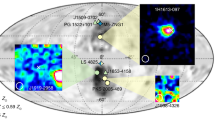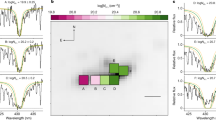Abstract
THE spectra of many QSOs are rich in narrow absorption lines. The still somewhat uncertain identifications suggest that the absorption is due to ions of ionisation potential <40 eV. If the ionisation is due to the radiation from a central source, then theoretical models1–4 give gas temperatures of <∼30,000 K. The absorption line systems are generally blueshifted with respect to the emission line redshift of the object. If these blueshifts are Doppler shifts then they correspond to velocities ranging from ∼0.001 to 0.5 of c (the velocity of light)5. The interpretation of these differential redshifts has been controversial5. Opinion has polarised about two extreme hypotheses—that all the absorption is due to intervening galaxies (the intervening hypothesis) or that it all arises in the vicinity of the QSO (the intrinsic hypothesis). At present, apparently the only way of mapping the Universe at large distances is by observing QSOs. The weakness of current models for intrinsic absorption has lead many to suppose that all the absorption occurs in intervening galaxies. If true, this has profound implications for the structure of the Universe. In particular, it implies that in the early Universe, galaxies had extremely large haloes (perhaps as large as 0.5 Mpc (ref. 6). Furthermore, it suggests that there also existed, at high z, large clusters of galaxies with velocity dispersions much greater than those hitherto observed at small z (refs 5, 7, 8). Because of the importance of these conclusions for galactic structure and evolution, it is obviously essential to determine what proportion, in fact, of the absorption systems are intrinsic to the QSOs. We present here an intrinsic model which seems to explain the essential features of many absorption systems. This is a crucial first step towards the eventual separation of the observations into intrinsic and intervening systems.
This is a preview of subscription content, access via your institution
Access options
Subscribe to this journal
Receive 51 print issues and online access
$199.00 per year
only $3.90 per issue
Buy this article
- Purchase on Springer Link
- Instant access to full article PDF
Prices may be subject to local taxes which are calculated during checkout
Similar content being viewed by others
References
Williams, R. E. Astrophys. J. 147, 556 (1967).
Davidson, K. Astrophys. J. 171, 213 (1972).
Davidson, K. Astrophys. J. 181, 1 (1973).
MacAlpine, G. M. Astrophys. J. 175, 11 (1972).
Perry, J. J., Burbidge, E. M. & Burbidge, G. R. Publ. Astr. Soc. Pacific 90, 337 (1978).
Roberts, D. H. et al. Astrophys. J. 224, 344 (1978).
Boksenberg, A. Phys. Scripta. 17, 205 (1978).
Boroson, T., Sargent, W. L. W., Boksenberg, A. & Carswell, R. F. Astrophys. J. 220, 722 (1978).
Bahcall, J. N. & Wolf, R. A. Astrophys. J. 152, 701 (1968).
Bahcall, J. N., Sargent, W. L. W. & Schmidt, M. Astrophys. J. Lett. 149, L11 (1967)
Williams, R. E., Strittmatter, P. A., Carswell, R. F. & Craine, E. R. Astrophys. J. 202, 296 (1975).
Sarazin, C. L., Flannery, B. P. & Rybicki, G. B. preprint (1978).
Mushotzky, R. F., Solomon, P. M. & Strittmatter, P. A. Astrophys. J. 174, 7 (1972).
Kippenhahn, R., Perry, J. J. & Röser, H.-J. Astr. Astrophys. 34, 211 (1974).
Kippenhahn, R., Mestel, L. & Perry, J. J. Astr. Astrophys. 44, 123 (1974).
Beltrametti, M. & Perry, J. J. Astr. Astrophys. (in preparation).
Dyson, J. E., Falle, S. A. E. G. & Perry, J. J. (in preparation).
Dyson, J. E. & de Vries, J. Astr. Astrophys. 20, 223 (1972).
Falle, S. A. E. G. Astr. Astrophys. 43, 323 (1975).
Kahn, F. D. Proc. 14th Int Cosmic Ray Conf., Munich (1975).
Röser, H.-J. Astr. Astrophys. (submitted).
Mestel, L., Moore, D. W. & Perry, J. J. Astr. Astrophys. 52, 203 (1976).
Author information
Authors and Affiliations
Rights and permissions
About this article
Cite this article
DYSON, J., FALLE, S. & PERRY, J. A wind driven shell model for the absorption line systems in QSOs. Nature 277, 118–120 (1979). https://doi.org/10.1038/277118a0
Received:
Accepted:
Published:
Issue Date:
DOI: https://doi.org/10.1038/277118a0
This article is cited by
-
Line forming regions in active galaxies and their nuclei
Astrophysics and Space Science (1996)
-
Flows and shocks in active galaxies and their nuclei
Astrophysics and Space Science (1995)
Comments
By submitting a comment you agree to abide by our Terms and Community Guidelines. If you find something abusive or that does not comply with our terms or guidelines please flag it as inappropriate.



